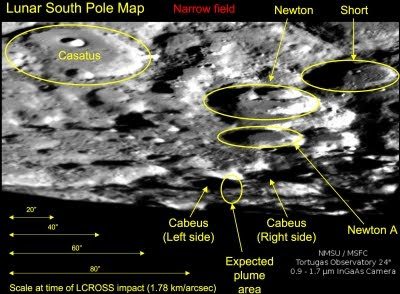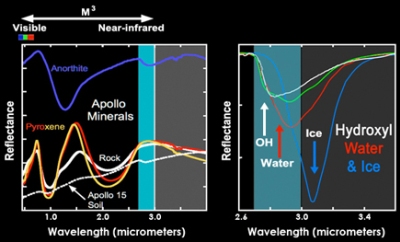 Informally, "amateur" experts, most equipped with knowledge and equipment that would have been the envy of Apollo mission planners mere decades ago, have been gearing up for the planned impact of LCROSS for more than two years, long before the experiment's frequent postponed launch with its companion vehicle, the Lunar Reconnaissance Orbiter (LRO).
Informally, "amateur" experts, most equipped with knowledge and equipment that would have been the envy of Apollo mission planners mere decades ago, have been gearing up for the planned impact of LCROSS for more than two years, long before the experiment's frequent postponed launch with its companion vehicle, the Lunar Reconnaissance Orbiter (LRO).Both have been in Space barely more than 100 days.
Among the photography of the lunar poles exchanged between the enthusiastic 'amateurs," for example, through their Google News Group, have appeared earth-bound images of the Moon easily superior to the image above that adorns NASA's Lunar Observation Campaign website, taken by the professionals using a 24 inch telescope.
Now the planning is tightened down to barely more than a week, when LCROSS will deliver the briefest sort of flash as it's kinetic energy is released, and excavating what is expected to be a 30 meter-wide, meter deep crater.
The source of the strong hydrogen signature found in both sunlit and permanently darkened craters like LCROSS targer crater Cabeus, and first discovered by the least expensive and most studied mission ever to the Moon, Lunar Prospector (1998) and its neutron spectrograph, may finally be understood. Hundreds of thousands of telescopes, large and small, throughout the Pacific Rim and beyond, will be watching, along with millions more on the web.
Meanwhile, the effect, if any, of results revealed a week ago verifying "widespread water and OH-bound minerals in the top two centimeters of the lunar surface, along with a fast-moving dynamic processes that comes and goes with the noon-day Sun, is quickly being dovetailed into long-thought-out formulae meant to determine what the data from the plume will be telling us.
It will be hard to top the buzz generated by the results announced from India's Chandrayaan and it's NASA-built "M-Qubed" (M3) RF mapper but the LCROSS impact could not be coming at a better prepared moment, with a world-wide audience ready to take a second look at our "new Moon."
































